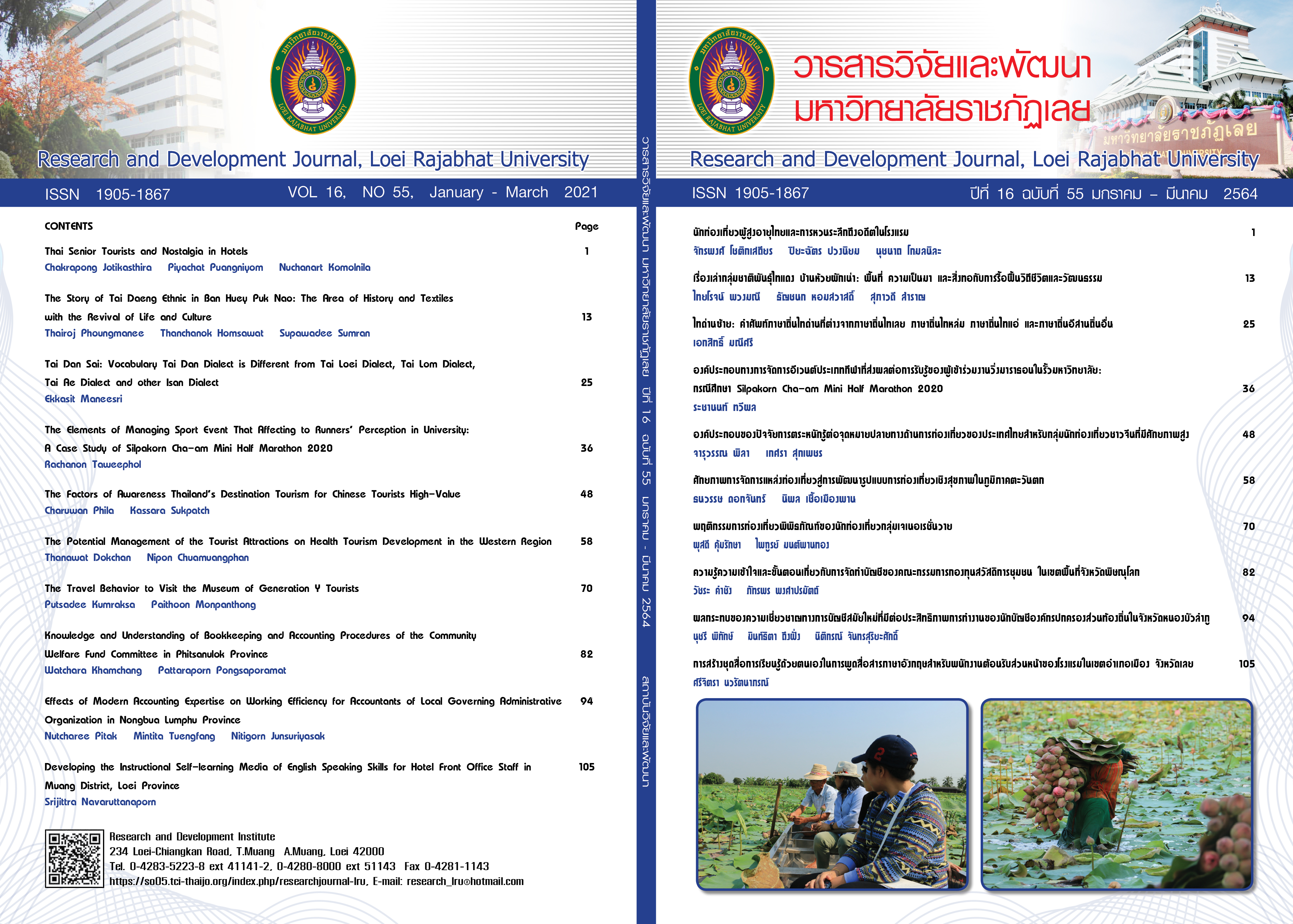The Factors of Awareness Thailand’s Destination Tourism for Chinese Tourists High-Value
Keywords:
destination/brand awareness, Chinese tourist high valueAbstract
This research aims to study “The Factors of Awareness Thailand's Destination Tourism for Chinese Tourists High-Value”. The objective of this research learns about the components of awareness Thailand’s destination tourism for Chinese tourists high-value. In term of quantitative data were collected by using the questionnaires from 400 Chinese tourists at Suvarnabhumi Airport. The sample data were analyzed by statistics such as Confirmatory factor analysis. Finally, The results revealed that, the Destination/Brand Awareness consisting of Top of mind, Brand recall, Brand recognition.
References
กรวรรณ สังขกร, และ คณะ. (2560). รายงานการวิจัยเรื่อง การพัฒนาและส่งเสริมการท่องเที่ยว: ตลาดนักท่องเที่ยวจีน (รายงานการวิจัย). เชียงใหม่: สถาบันวิจัยสังคม มหาวิทยาลัย เชียงใหม่. สืบค้นจาก http://www.sri.cmu.ac.th/~ctrd/uploads/files/file_20171206_1512541832.pdf
เกศรา สุกเพชร และ โชคชัย สุเวชวัฒนกูล. (2558). รายงานการวิจัยเรื่อง กลยุทธ์การจัดการโซ่อุปทานการท่องเที่ยวไทยเพื่อการรองรับนักท่องเที่ยวจีนกลุ่มคุณภาพ (รายงานการวิจัย). กรุงเทพฯ: สถาบันบัณฑิตพัฒนบริหารศาสตร์ ศูนย์ศึกษาการจัดการการท่องเที่ยวแบบบูรณาการ.
วสวัตติ์ สุติญญามณี. (2562). สังคมสูงวัยกับรูปแบบการท่องเที่ยว: ปัจจัยที่ส่งผลต่อการตัดสินใจในการเลือกรูปแบบการท่องเที่ยวของผู้สูงอายุในเขตกรุงเทพฯและปริมณฑล. วารสารศรีปทุมปริทัศน์ ฉบับมนุษยศาสตร์และสังคมศาสตร์, 19(1), 95-109.
การท่องเที่ยวแห่งประเทศไทย. (2558). รายงานสรุปฉบับผู้บริหารโครงการศึกษาตลาดนักท่องเที่ยวศักยภาพสูงจีน อินเดีย รัสเซีย. กรุงเทพฯ: บริษัท อินทัช รีเสิร์ช แอนด์ คอนซัลแทนซี่ จำกัด.
การท่องเที่ยวแห่งประเทศไทย. (2560). รายงานประจำปี 2560. สืบค้นจาก https://www.tat.or.th/th/about-tat/annual-report
ศูนย์ข้อมูลเพื่อธุรกิจไทยในจีน สถานเอกอัครราชทูต ณ กรุงปักกิ่ง. (2560). รายได้ชาวจีนใน 31 มณฑลเมืองประจำปี 2559 เซี่ยงไฮ้ ปักกิ่ง และเจ้อเจียงติด 8 อันดับแรก. สืบค้นจาก https://www.thaibizchina.com/%E0%B8%A3%E0%B8%B2%E0%B8%A2%E0%B9%84%E0%B8%94%E0%B9%89%E0%B8%8A%E0%B8%B2%E0%B8%A7%E0%B8%88%E0%B8%B5%E0%B8%99%E0%B9%83%E0%B8%99-31-%E0%B8%A1%E0%B8%93%E0%B8%91%E0%B8%A5-%E0%B9%80%E0%B8%A1%E0%B8%B7/
Aaker (1991). Managing brand equity: capitalizing on the value of a brand name. New York: A Division of Simon & Schudter Inc.
Barreda, A. A., Bilgihan, A., Nusair, K., & Okumus, F. (2015). Generating brand awareness in Online Social Networks. Computers in Human Behavior, 50, 600-609. Doi: 10.1016/j.chb.2015.03.023
Ghodeswar, B. M. (2008). Building brand identity in competitive markets: a conceptual model. Journal of Product & Brand Management, 17(1), 4-12.
Keller, K. L. (2013). Strateic Brand Management Building, Measuring, And Manaing Brand Equity. England: Pearson Education Limited.
Laemlaksakul, T. (2016). Developing perceptions and brand equity to enhance the potential of adventure tourism in bencha burapha suvarnabhumi provinces. (Doctoral dissertation). Tourism Management, Graduate School, National Institute of Development Administration. Retrieved from http://libdcms.nida.ac.th/thesis6/2016/b196956.pdf
Szőcs, A., & Berács, J. (2015). A Causal Model of Consumer-Based Brand Equity. Acta University. Sapientiae, Economics and Busines, 3(1), 5-26. Doi: 10.1515/auseb-2015-0001
Downloads
Published
How to Cite
Issue
Section
License
ข้อความที่ปรากฎในวารสารฉบับนี้เป็นความคิดเห็นของผู้เขียนแต่ละท่าน สถาบันวิจัยและพัฒนา มหาวิทยาลัยราชภัฏเลย และกองบรรณาธิการ ไม่จำเป็นต้องเห็นด้วยและไม่มีส่วนรับผิดชอบใดๆ
สถาบันวิจัยและพัฒนา มหาวิทยาลัยราชภัฏเลย ขอให้ผู้อ่านอ้างอิงในกรณีที่ท่านคัดลอกเนื้อหาบทความในวารสารฉบับนี้






